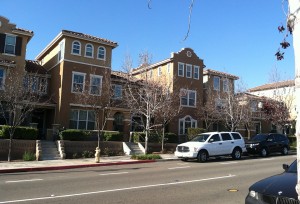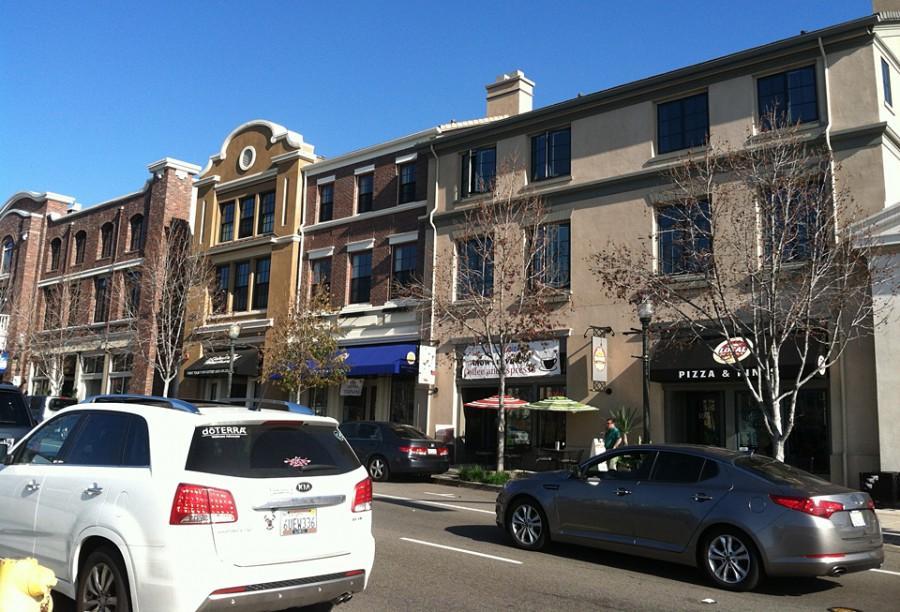Point of View: Housing mandate could doom Encinitas by design
California law has no room for community character
High-density residential-commercial complexes such as MarketWalk in San Elijo Hills, pictured Feb. 8, might fit the master-planned community, but do they belong in Olivenhain? (North Coast Current photo)
February 8, 2015
 “Community character” is a phrase that’s been batted about for months as Encinitas debates the shape of its state-mandated Housing Element, a plan that requires an accounting of how the city is going to accommodate population growth, affordable housing and environmental stewardship.
“Community character” is a phrase that’s been batted about for months as Encinitas debates the shape of its state-mandated Housing Element, a plan that requires an accounting of how the city is going to accommodate population growth, affordable housing and environmental stewardship.
The Encinitas City Council voted Feb. 5 to move forward with environmental reviews of three maps that point to potential sites where affordable housing units could be placed. The maps are part of an ongoing process to satisfy the state’s requirement. For Encinitas, that means 1,283 units for lower-income families, 413 units for moderate-income and 907 units for above-moderate-income.
The quest for affordable housing is important, regardless of a state initiative. According to a city report issued in January, the median home price in Encinitas is $769,000 — 24 percent higher than the North Coast median price of $619,000. The average rent for a two-bedroom apartment in the city is $1,869. More than a quarter of the city’s extremely low-income residents are age 65 and older.
There’s little doubt that a state affordable-housing requirement is helpful. But what if the very notion of such a state-mandated plan runs counter to a community’s character?
It’s a question worth asking, with no easy answers. It’s also one I ask with reservation because I am one of those Encinitas residents who was raised here pre-1980s, now barely able to afford to live in the very community I grew up in.
The state’s assumption seems to be unending community growth — not maintenance — of a community.
California is asking Encinitas to account for how it will accommodate a growing population through working in affordable housing access. That in itself is not an issue. A community should be affordable to all who wish to live in it. Encinitas is not a gate-guarded housing development run by a homeowners association — although some might like it to be.
No matter what side you’re on in this intense debate, all signs point to one sad conclusion — the unique characters of Encinitas’ five communities are likely doomed.
Read the wording from the state’s Department of Housing and Community Development: “The law acknowledges that, in order for the private market to adequately address housing needs and demand, local governments must adopt land use plans and regulatory systems which provide opportunities for, and do not unduly constrain, housing development.”
In other words, the state is mandating that communities physically grow. That’s a valid — and alarming — interpretation of the above passage.
How does one define the “undue constraint” of housing development in a community? How do you define development “opportunities?”
State and regional agencies tell us that the need for this Housing Element is based on projected population increases, decades into the future. Has no one considered that state and local governments are approaching the issue of housing from a flawed perspective? At what point does a population growth projection become a self-fulfilling prophecy rather than a simple reality of numbers?
That’s where the question of state motive comes into play based on its own words.
Density by default
It’s quite possible that the existence of this California requirement has the destruction of a community’s character unconsciously built into it. No amount of shoehorning growth projections into a plan can possibly protect the unique spirit of a community — and quality of life for all — if the assumption is that such character doesn’t exist in the first place.
This approach is reminiscent of school district budget battles where the numbers matter more than the spirit of the educational goals. As an educator and lead faculty member of an instructional program, I speak from my own observations.
In a Nov. 23, 2010, letter to the San Diego Association of Governments (SANDAG), the state Department of Housing and Community Development said the San Diego region as a whole must meet the following elements: “(1) increasing the housing supply and mix of housing types, tenure, and affordability; (2) promoting infill development and socioeconomic equity, protecting environmental and agricultural resources, and encouraging efficient development patterns; (3) promoting an improved intraregional relationship between jobs and housing; (4) balancing the distribution of households by income category.”
Encinitas is a cog in the wheel of this process.
The city is addressing its Housing Element — a contentious process so far — because it has been out of state compliance for some time. Basically, it’s illegal for the city not to have such a growth objective as part of its General Plan. City officials fear lawsuits and loss of funding resources if Encinitas doesn’t get its act together.
The heart of the debate in Encinitas tends to be the density of housing (units per acre) and where that housing goes. According to a report from the city of Encinitas, based on state mandates, “In order to accommodate regional housing needs for the very low/low income households, a default density of 30 units per acre is required for San Diego jurisdictions with populations over 25,000. This density is typically achieved in three-story multifamily buildings.”
According to the city, Encinitas does not have enough sites to accommodate this housing obligation. Throw Proposition A into the mix, and Encinitas has a bigger challenge on its hands. Prop. A sets a general building height of two stories with a public vote for height and density changes. It’s fair to say that Encinitas residents approved Prop. A to prevent exactly what the state is demanding of the city.
Aside from engaging in a mini-war with a neighboring city to grab more land, Encinitas has to find a way to cram the state’s mandate inside its borders. This is a no-win situation. It might sound fatalistic or cynical, but that’s the emerging picture. There is always hope that the picture can change, of course, but we have to look at what’s in front of us now.
Olivenhain’s “fair share”
The city’s January report, based on a process that included community feedback from a controversial online system called e-Town Hall, breaks down each Encinitas community’s share of the state mandate.
Old Encinitas, Leucadia and New Encinitas could share 23 to 24 percent of the mandated housing units each, equating to a 5 to 6 percent increase over the number of housing units already in those communities. Cardiff could share 15 percent of the load, with a 4 percent increase over the current amount of housing, according to the city’s numbers.
And then there’s Olivenhain.
The lone semi-rural holdout of Encinitas would also share 15 percent of the mandated housing units, according to the city. But that equates to an 8 percent increase over the current amount of housing there — more than any of the city’s other communities.
For Olivenhain, that 8 percent increase equates to 192 new homes, according to the city’s report. It’s a disproportionate increase for the community, and begs a discussion of whether it’s realistic to call Olivenhain “rural” in any sense.

If that 8 percent means a new development of three-story townhomes, for example, drive through San Elijo Hills in San Marcos and tour the Morgan’s Corner neighborhood. Morgan’s Corner is a single development of 162 townhomes. It’s a prominent suburban block at the entrance of San Elijo Hills.
Across the way from Morgan’s Corner, there’s Village Square, a three-story cluster of mixed-use space predominantly made up of 121 tightly squeezed townhomes.
The point is that, in these examples, the number of units per neighborhood is less than 192 — but look at the hulking blocks of the neighborhoods themselves, and it begs the question of whether that belongs in Olivenhain. The town is not a master-planned community designed to hold such neighborhoods. It’s more than a century old with a tradition of rural lifestyle and agriculture.
The hills of semi-rural Olivenhain have already been shaved down enough. Would neighborhoods of townhomes this size fit the character of that community?
In its report, the city claims that the overall proposal “maintains community character.” That is an unrealistic statement based on Olivenhain alone.
Unsolvable contradiction
As the Housing Element process moves forward, it’s worth considering whether the state’s affordable housing mandate, as designed now, actually works against itself.
The state’s letter to SANDAG in 2010 discusses requirements to protect “environmental and agricultural resources,” encourage “efficient development patterns,” promote “an improved intraregional relationship between jobs and housing” and balance “the distribution of households by income category.”
How is any of this truly achieved by the state’s current plug-in-the-numbers approach in which Encinitas faces a no-win situation?
Environmental and agricultural resources? The state discusses the use of infill projects to satisfy affordable housing mandates. In Encinitas, that infill comes at the cost of what’s left of the city’s agricultural heritage. Many of today’s neighborhoods sit on what used to be Encinitas’ “environmental and agricultural resources.”
Efficient development patterns and household income distribution? It remains to be seen whether Encinitas can successfully prevent neighborhoods of “haves” and “have-nots” boxed in to a patchwork of developments walled off from each other. That’s economic distribution in practice, not in spirit.
An intraregional relationship between jobs and housing? Encinitas is referred to as a “bedroom community” for a reason. Residents most often leave here for jobs elsewhere in the region. What jobs there are in Encinitas are largely service oriented, and I can’t tell you how many times I’ve talked to or overheard cashiers, baristas and others discuss living as far away as North Park and working here, nearly 30 miles from home. I would argue that a disproportionate number of Encinitas residents do not — and cannot — work in this city. The overall service economy here doesn’t support the ability to maintain a household. That’s not intraregional.
San Diego County, through SANDAG, must work within these state mandates. Cities such as Encinitas are the communities that build the larger county picture within those demands.
The state’s mandated Housing Element in law contradicts itself in practice. Encinitas might have to follow the law, but perhaps it’s time for residents and elected leaders to think beyond it and push the system a bit. Talk to state representatives and find ways to refine the law. Change, in this effort, really does begin at home.
Roman S. Koenig is editor and publisher of the North Coast Current. Columns are the opinions of the writer and do not necessarily reflect the opinions of North Coast Current ownership. Comment below or submit letters to the editor at letters@northcoastcurrent.com.





